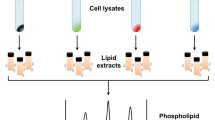Summary
Oxidative modification of low-density lipoprotein (LDL) may play an important role in the initiation and progression of atherosclerosis. We previously showed that the cytotoxicity of oxidized LDL (oxLDL) depended on the level of lipid hydroperoxides. Meanwhile, it has been shown that during LDL oxidation, a significant part of the LDL phosphatidylcholine (PC) is degraded to lysophosphatidylcholine (LPC) by an intrinsic phospholipase A2-like activity, and that LPC is toxic to various cells. In the present study, we compared the toxicity of oxLDL with that of LPC in cultured bovine aortic endothelial cells. Cytotoxicity induced by LPC, assessed by the release of lactate dehydrogenase (LDH), reached a plateau within 1h. LDH release induced by oxLDL occurred much later, at about 3h, and increased linearly until nearly all the LDH was released at 10h. The addition of deferoxamine, a Fe3+ chelator, to the reaction medium prevented the toxic effects of oxLDL, but not of LPC. Native LDL and oxLDL inhibited the toxicity of LPC, while native LDL promoted the toxicity of oxLDL. Albumin inhibited the toxicity of LPC but not of oxLDL. Preincubation of endothelial cells with an antioxidant, probucol, protected against oxLDL toxicity, but not against LPC toxicity. These results suggest that lipid hydroperoxides associated with the oxLDL particle, not LPC, constitute the toxic moiety of oxLDL. These substances may generate lipid peroxyl and alkoxyl radicals in the presence of ionic iron, probably from intracellular iron stores in endothelial cells, and produce cytotoxicity.
Similar content being viewed by others
References
Steinberg D, Parthasarathy S, Carew TE, Khoo JC, Witztum JL (1989) Beyond cholesterol. Modifications of low-density lipoprotein that increase its atherogenicity. N Engl J Med 320:915–924
Kuzuya M, Naito M, Funaki C, Hayashi T, Asai K, Kuzuya F (1991) Lipid peroxide and copper are required for the toxicity of oxidized low density lipoprotein to cultured endothelial cells. Biochim Biophys Acta 1096:155–166
Steinbrecher UP, Parthasarathy S, Leake DS, Witztum JL, Steinberg D (1984) Modification of low density lipoprotein by endothelial cells involves lipid peroxidation and degradation of low density lipoprotein phospholipids. Proc Natl Acad Sci USA 81:3883–3887
Parthasarathy S, Steinbrecher UP, Barnett J, Witztum JL, Steinberg D (1985) Essential role of phosholipase A2 activity in endothelial cell-induced modification of low density lipoprotein. Proc Natl Acad Sci USA 82:3000–3004
Chisolm GM (1991) Cytotoxicity of oxidized lipoproteins. Curr Opin Lipidol 2:311–316
Ohkawa H, Ohishi N, Yagi K (1979) Assay for lipid peroxides in animal tissues by thiobarbituric acid reaction. Anal Biochem 95:351–358
Naito M, Hayashi T, Kuzuya M, Funaki C, Asai K, Kuzuya F (1989) Vascular endothelial cell migration in vitro. Roles of cyclic nucleotides, calcium ion and cytoskeletal system. Artery 17:21–31
Mukherjee KD, Spaans H, Haahti E (1971) New detector systems for thin-layer chromatography. J Chromatogr 61:317–321
Cotgreave K, Lynes A (1967) Quantitative analysis by thin-layer chromatography using a flame ionization detector. J Chromatogr 30:117–124
Lowry OH, Rosebrough NJ, Farr AL, Randall RJ (1951) Protein measurement with the folin phenol reagent. J Biol Chem 193:263–275
Noble RP (1968) Electrophoretic separation of plasma lipoproteins in agarose gel. J Lipid Res 9:693–700
Kuzuya M, Naito M, Funaki C, Hayashi T, Asai K, Kuzuya F (1989) Protective role of intracellular glutathione against oxidized low density lipoprotein in cultured endothelial cells. Biochem Biophys Res Commun 163:1466–1472
Naito M, Kuzuya M, Kuzuya F (1990) Effects of low density lipoproteins on vascular wall cells. J Jpn Atheroscler Soc 18:827–831
Kuzuya M, Naito M, Funaki C, Hayashi T, Asai K, Kuzuya F (1991) Probucol prevents oxidative injury to endothelial cells. J Lipid Res 32:197–204
Kuzuya M, Yamada Y, Hayashi T, Funaki C, Naito M, Asai K, Kuzuya F (1992) Role of lipoprotein-copper complex in copper catalyzed-peroxidation of low-density lipoprotein. Biochim Biophys Acta 1123:334–341
Steinbrecher UP, Pritchard PH (1989) Hydrolysis of phosphatidylcholine during LDL oxidation is mediated by platelet-activaing factor acetylhydrolase. J Lipid Res 30:305–315
Quinn MT, Parthasarathy S, Steinberg D (1988) Lysophosphatidylcholine: a chemotactic factor for human monocytes and its potential role in atherogenesis. Proc Natl Acad Sci USA 85:2805–2809
Katz AM (1982) Membrane-derived lipids and the pathogenesis of ischemic myocardial damage. J Mol Cell Cardiol 14:627–632
Takeda A, Palfree GER, Forsdyke RD (1982) Roles of serum in inhibition of cultured lymphocytes by lysophosphatidylcholine. Biochim Biophys Acta 710:87–98
Matsuzaki K, Handa T, Miyajima K, Mikura Y, Shimizu H, Taguchi H (1988) Quantitative analysis of hemolytic action of lysophosphatidylcholines in vitro: effects of acyl chain structure. Chem Pharm Bull 36:4253–4260
Niewoehner DE, Rice K, Duane P, Sinha AA, Gebhard R, Wangensteen D (1988) Induction of alveolar epithelial injury by phospholipase A2. J Appl Physiol 66:261–267
Fleer EAM, Kim DJ, Nagel GA, Eibl H, Unger C (1990) Cytotoxic activity of lysophosphatidylcholine analogues on human lymphoma Raji cells. Onkologie 13:295–300
Kuzuya M, Naito M, Yamada K, Funaki C, Hayashi T, Asai K, Kuzuya F (1990) Involvement of intracellular iron in the toxicity of oxidized low density lipoprotein to cultured endothelial cells. Biochem Int 22:567–573
Gannon DE, Varani J, Phan SH, Ward JH, Kaplan J, Till GO, Simon RH, Ryan US, Ward PA (1987) Source of iron in neutrophil-mediated killing of endothelial cells. Lab Invest 57:37–44
Ungemach FP (1987) Pathobiochemical mechanisms of hepatocellular damage following lipid peroxidation. Chem Phys Lipids 45:171–205
Serhan C, Anderson P, Goodman E, Dumhan P, Weissmann GJ (1981) Phosphatidate and oxidized fatty acids are calcium ionophores. Biol Chem 256:2736–2741
Steinbrecher UP, Zhang H, Lougheed M (1990) Role of oxidatively modified LDL in atherosclerosis. Free Radic Biol Med 9:155–168
Author information
Authors and Affiliations
Rights and permissions
About this article
Cite this article
Naito, M., Yamada, K., Hayashi, T. et al. Comparative toxicity of oxidatively modified low-density lipoprotein and lysophosphatidylcholine in cultured vascular endothelial cells. Heart Vessels 9, 183–187 (1994). https://doi.org/10.1007/BF01746062
Received:
Revised:
Accepted:
Issue Date:
DOI: https://doi.org/10.1007/BF01746062




